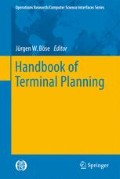Abstract
Currently, several container terminals are being expanded, redesigned or newly built. In all those cases the layout of the container terminal has to be designed. We discuss different technologies which can be used for container terminal operation and describe their impact on the terminal layout. Different container terminal layout categories are defined. For a layout which is typical for the use of automated rail-mounted gantry cranes we propose a procedure to calculate promising storage yard configurations. The results show that smaller block widths lead to higher yard performances, but also to higher cost. Using the proposed block design problem, we are able to calculate all non-dominated solutions, which enables terminal planners to choose a solution for their specific situation. Moreover, we analyze the impact of the reefer racks distribution on the yard performance. The results show that an equal distribution of reefer racks over the existing storage blocks allows the best workload distribution.
Access this chapter
Tax calculation will be finalised at checkout
Purchases are for personal use only
Preview
Unable to display preview. Download preview PDF.
References
Annala I (2007) Shuttle applications offer mega results. Kalmar around the world (3):4–5
Asef-Vaziri A, Khoshnevis B, Rahimi M (2008) Design and analysis of an automated container handling system in seaports. International Journal of Agile Systems and Management 3(1/2):112–126
Brinkmann B (2005) Seehäfen Planung und Entwurf. Springer, Berlin
Chu CY, Huang WC (2005) Determining container terminal capacity on the basis of an adopted yard handling system. Transport Reviews 25(2):181–199
Ficke S, Schütt H (2008) ConRoCAPS – Modelling Intermodal Terminals to Calculate their Capacity. In: Proceedings of the 11th International Workshop on Harbour, Maritime & Multimodal Logistics Modeling & Simulation, DIPTEM Press, Genova, pp 246–250
Froyland G, Koch T, Megow N, Duane E, Wren H (2008) Optimizing the landside operation of a container terminal. OR Spectrum 30:53–73
Hu YH, Huang SY, Chen C, Hsu WJ, Toh AC, Loh CK, Song T (2005) Travel time analysis of a new automated storage and retrieval system. Computers & Operations Research 32(6):1515–1544
Hu YH, Zhu ZD, Hsu WJ (2008) As/rs based yard and yard planning. Journal of Zhejiang University – Science A 9(8):1083–1089
Kalmar Industries (2010) KALMAR E-DRIVE® ESC W STRADDLE CARRIERS. www.kalmarind.com/show.php?id=1020636, accessed August 25, 2010
Kim KH, Park YM, Jin MJ (2008) An optimal layout of container yards. OR Spectrum 30(4):675–695
Liu CI, Jula H, Ioannou P (2002) Design, simulation, and evaluation of automated container terminals. IEEE Transactions on Intelligent Transportation Systems 3(1):12–26
Liu CI, Jula H, Vukadinovic K, Ioannou P (2004) Automated guided vehicle system for two container yard layouts. Transportation Research Part C 12:349–368
Petering MEH (2008) Parallel versus Perpendicular Yard Layouts for Seaport Container Transshipment Terminals: An Extensive Simulation Analysis. In: Proceedings of the International Trade and Freight Transportation Conference (Ayia Napa, Cyprus), CD-ROM Publication, pp 117–127
Petering MEH (2009) Effect of block width and storage yard layout on marine container terminal performance. Transportation Research Part E: Logistics and Transportation Review 45:591–610
Petering MEH, Murty KG (2009) Effect of block length and yard crane deployment systems on overall performance at a seaport container transshipment terminal. Computers & Operations Research 36(5):1711–1725
Roodbergen KJ, Vis IF (2009) A survey of literature on automated storage and retrieval systems. European Journal of Operational Research 194(2):343–362
Saanen YA, Valkengoed MV (2005) Comparison of Three Automated Stacking Alternatives by Means of Simulation. In: WSC ’05: Proceedings of the 37th Conference on Winter Simulation, Winter Simulation Conference, pp 1567–1576
Stahlbock R, Voß S (2008) Operations research at container terminals: a literature update. OR Spectrum 30(1):1–52
Vis IFA (2006) A comparative analysis of storage and retrieval equipment at a container terminal. International Journal of Production Economics 103(2):680–693
Wiese J, Kliewer N, Suhl L (2009a) A Survey of Container Terminal Characteristics and Equipment Types. Technical Report 0901, DS&OR Lab, University of Paderborn, Paderborn
Wiese J, Suhl L, Kliewer N (2009b) Mathematical programming and simulation based layout planning of container terminals. International Journal of Simulation and Process Modelling 5:313–323
ZPMC (2009) Shanghai Zhenhua Heavy Industry Co.Ltd – ZPMC’S Ten Technology Achievements of RTG. http://www.zpmc.com/view.php?cid=26&tid=105&page=5, accessed August 25, 2010
Author information
Authors and Affiliations
Corresponding author
Editor information
Editors and Affiliations
Rights and permissions
Copyright information
© 2011 Springer Science+Business Media, LLC
About this chapter
Cite this chapter
Wiese, J., Suhl, L., Kliewer, N. (2011). Planning Container Terminal Layouts Considering Equipment Types and Storage Block Design. In: Böse, J. (eds) Handbook of Terminal Planning. Operations Research/Computer Science Interfaces Series, vol 49. Springer, New York, NY. https://doi.org/10.1007/978-1-4419-8408-1_12
Download citation
DOI: https://doi.org/10.1007/978-1-4419-8408-1_12
Published:
Publisher Name: Springer, New York, NY
Print ISBN: 978-1-4419-8407-4
Online ISBN: 978-1-4419-8408-1
eBook Packages: Business and EconomicsBusiness and Management (R0)

